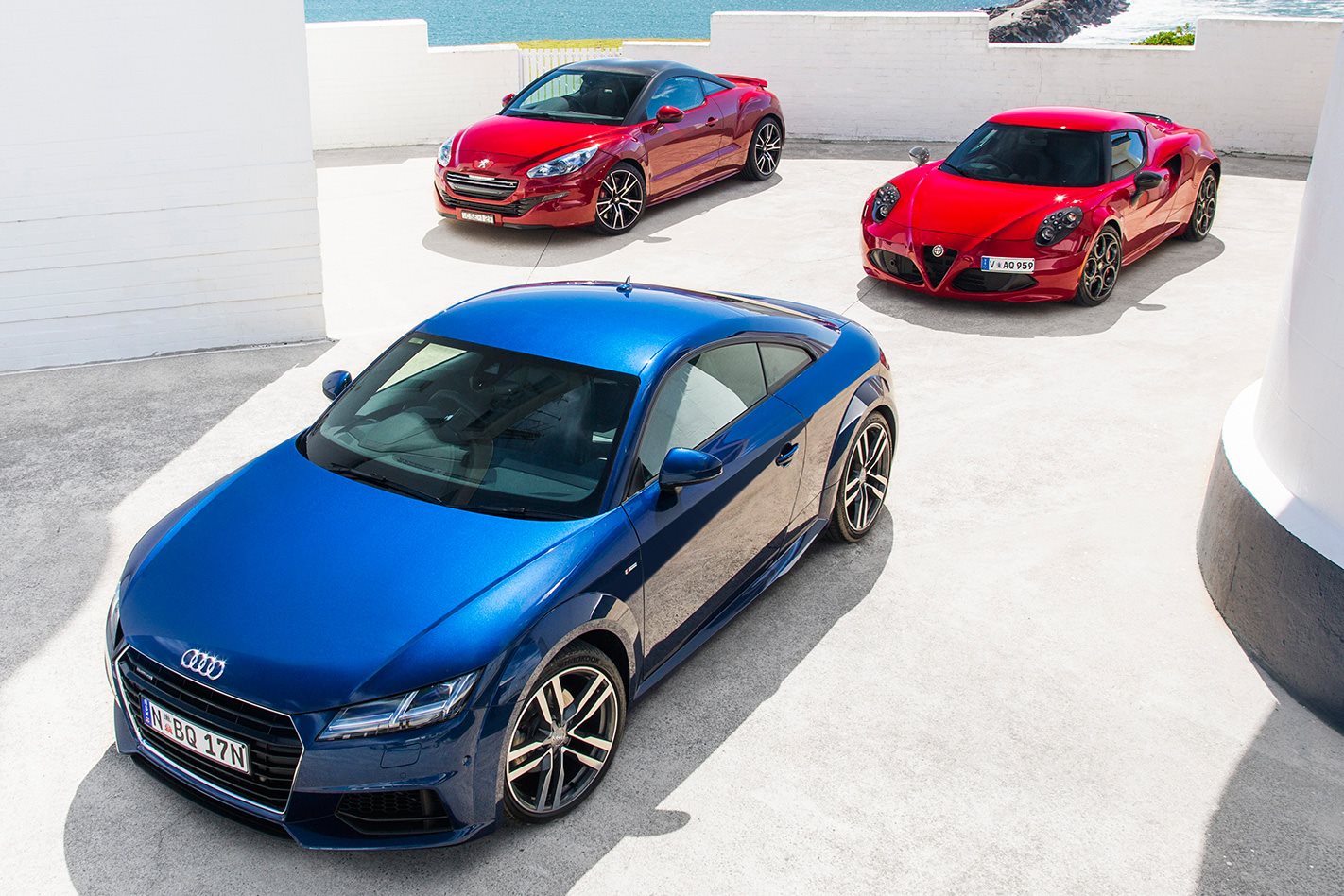A cheap Italian supercar, a sharply suited German, or a firey, bolshy Frenchie? Better bring your gloves!
First published in the June 2015 issue of Wheels magazine, Australia’s most experienced and most trusted car magazine since 1953.
Can’t wait to see the final scores? Jump to the verdict now.
POP QUIZ: what was the last brilliant Alfa to grace Aussie roads? No, not 2010’s appealingly Italianate Giulietta, likeable as it is, and certainly not the bloody Mito. Nothing for at least a generation, then, and by that we don’t mean 2005’s striking Brera.
Clearly, patience is a virtue that would serve any Alfa Romeo enthusiast well because to uncover the gold, you have to dig much deeper into the brand’s back catalogue, at least three or four decades (we’re deliberately overlooking the ’89 Sprint Zagato and ’07 8C Competizione on the grounds of availability and relevance in Oz).
For our money, the last real Alfa Romeo was the Alfetta/GTV, with its twin-cam four (and later V6), and rear transaxle with inboard brakes. That’s in terms of the ability to hook a driver, before reeling you in with that indefinable element we call character.
An Alfa serpent hasn’t slithered on a snout as sensuous and exotic as 2015’s newcomer since the original Spider (1966-93). And you have to cast your mind back further still to find the last lightweight sports car to wear the emblem, at which point you’re back in the days of Alfa Romeo as an F1 engine supplier, and the mid-engined 33 Stradale (1967-69).
All of which makes the 4C the most electrifying Alfa – by a miglio – for about half a century. Take it from us, with a body like this, and in its initial months on sale, the 4C turns heads like nothing else, and it has the talent to go with it.
Evolution, not revolution

Okay, it won’t win a style stand-off with the low and wide 4C, but it has aces of its own. At anything less than Bentley prices, Audi cabins are peerless and the TT’s takes on a techno-cool slant centred on its new TFT-screen instrument cluster.
Audi’s evergreen sporty coupe brings a newfound nod to driver appeal, too, with more rear bias for its quattro all-wheel-drive system and variable-ratio steering among the improvements.
A return to form
JUST LIKE the long-suffering Alfisti, it paid for the average Francophile to be the persevering type. They’d been waiting since the dawn of the millennium and the demise of the Peugeot 306 – perhaps longer – before being rewarded in 2009 when the French marque embarked on a return to form with the RCZ.
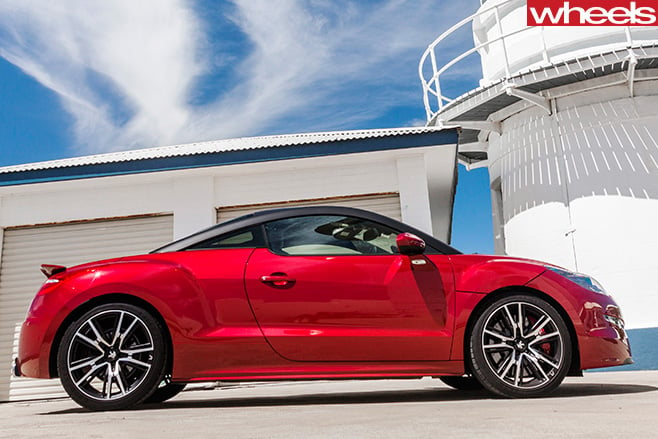
In the case of the RCZ, shooting for a slice of TT sales without blatantly ripping off its design isn’t in the league of achievement of the 205 GTi and its gift to hot-hatching (can the fact there’s a single millimetre between the coupes in overall height be coincidence?). But the RCZ’s double-bubble, cab-forward canopy gives it head-turning individuality (and a great boot) to make it worth ditching the more obvious Deutsch alternative.
Philosophical differences
OKAY, that’s it for history and philosophy. Onto pragmatics, and anyone seriously considering an Alfa Romeo 4C probably wouldn’t be remotely interested in a TT or an RCZ, mere coupes to the Italian brand’s exotic sportster. Conversely, anyone with even a passing interest in long-haul comfort and refinement or day-to-day usability – or who needs to seat more than two – won’t even consider a 4C. Well, if their blood is red they may for a while, but they’ll be dreaming.
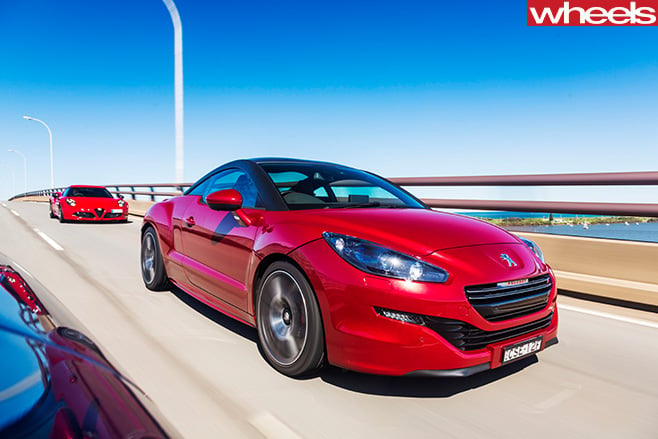
The Audi TT S-line quattro costs $85,450 in standard form and sits atop a TT hierarchy that opens with a $72K front-driver. Add options and the flagship quickly heads north of $90K, as it did when S-line leather, Band & Olufsen audio, matrix LED headlights and an assistance pack were added to our test car.
The RCZ-R is Peugeot’s priciest coupe, but it’s the cheapest car here at $68,990, and differs from its rivals in that it has a gear lever and a clutch operated by the driver’s left leg, rather than a pair of them operated via paddles by a computer.
An arresting experience
BEYOND the six-speed gearboxes, there’s welcome drivetrain diversity in the Alfa’s mid-engined form to the others’ front engines, and the fact that with a front-drive, a rear-drive and an all-wheel-drive represented, no two share the same layout.
On a scribbly stretch of road north-west of Sydney, the 4C’s unassisted steering, via a small, over-sculpted wheel, relays why mid-engine and rear-drive is rightly regarded as the purest and the best.
Away from parking duties, the steering is light and arrows the nose into corners. It loads up to signpost the transition of load from one end of the chassis to the other, the wheel jiggling and kicking in your palms, which are necessarily wrapped tightly around its rim.
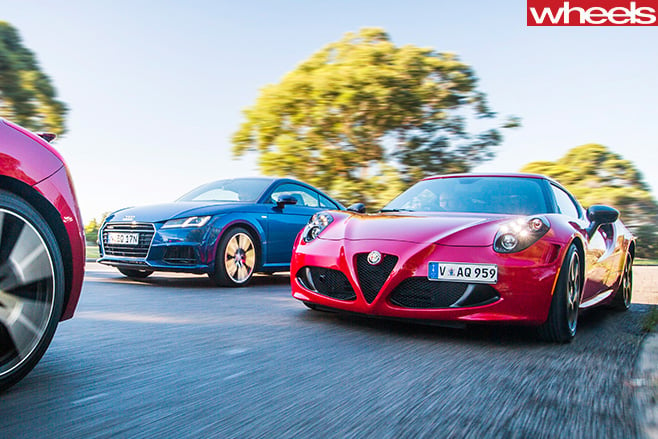
Its Giulietta-sourced, ‘1750’ turbo engine is as much a part of the 4C experience as its uncommonly challenging dynamics offered by the carbonfibre tub chassis manufactured by Dallara and shared with the KTM X-Bow. Every degree of pivot at the right ankle brings a furious whoosh and whistle from the intercooled, twin-cam 177kW turbo four, which sits just over your left shoulder. It’s loud enough in the cabin that it drowns out much of the exhaust raucousness, which is clearly audible from outside, and every bit the baby supercar in flavour.
The 4C’s ability to blitz the dragstrip is a bit deceptive. On the road, there are so many distractions – the induction cacophony and the fondness of the dual-clutch gearbox for kicking down – that it’s difficult to gauge the level of shove-in-the-back. The test equipment isn’t fooled, though; the 4C is more or less true to its maker’s claims, being capable of easy 4.6-second 0-100s, as well as 12.8sec quarters using the lesser launch control mode (full whack sees a high-rev clutch dump, and a quick time wheelspun away).
Pragmatism on point
THE performance of the 169kW 2.0-litre turbo Audi is deceptive in a different way. It sprints the strip with a carefully metered launch-control getaway and such calmly measured shifts that the speed seems unremarkable, yet it does a 5.5sec sprint and high-13 quarters, which is quicker than it feels on the road.
The TT’s back-road flavour departs from the 4C’s full driver immersion to bring a point-and-shoot personality. If the Alfa is a go-kart, the Audi is more like a couped-up hot hatch.
You must drive the Alfa by the scruff of its neck, whereas you have a choice in the Audi. However, the reward for wringing the TT out is more tangible than it has ever been in any previous generation.
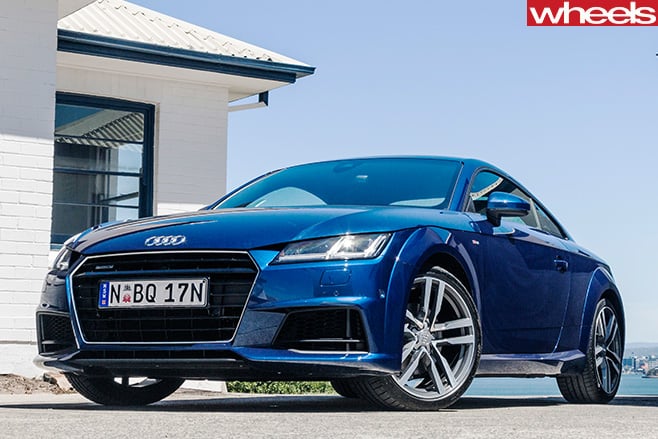
The TT’s dual-clutch ’box is immediately responsive – more so than the 4C’s, which can be slow and uncooperative – and brings a beautifully judged crack from the tailpipes on upshifts, while the engine has just enough character, as long as you’re in the upper reaches of throttle and revs.
However, especially in the company of the Alfa, it’s all a bit too easy and detached. As comparo wingman Ponch put it, you can think about what you’re going to have for dinner while punting the Audi, but there isn’t enough spare brainpower to process anything else when you’re arm-wrestling the Alfa.
French Connection
THE Peugeot’s manual gearbox – a six-speed stick-shift is the only transmission available – gives it an advantage as a driver’s car, and the RCZ-R needs an easy win given it’s at a disadvantage in some other areas from the outset. For example, where the Audi nails cabin functionality, tactility and comfort, and the Alfa eschews superfluous luxury in its quest for heightened purpose, the Peugeot’s cabin, which was a nice effort six years ago, feels a bit dated.
Coming to the French coupe’s defence are the talent and cohesion of its chassis, the potency of its powertrain, and the fact it’s tens of thousands less expensive than its rivals, which are no small points.
The 1.6-litre turbo Peugeot cedes cubic capacity to both its rivals, yet at 199kW it’s the most powerful, and just 20kg heavier than the Audi. Without the Audi’s all-wheel drive (or dual-clutch gearbox), the RCZ-R can’t match the TT on the strip, but its superior in-gear acceleration figures (and terminal speed) illustrate just how quick it is in many real-world scenarios.
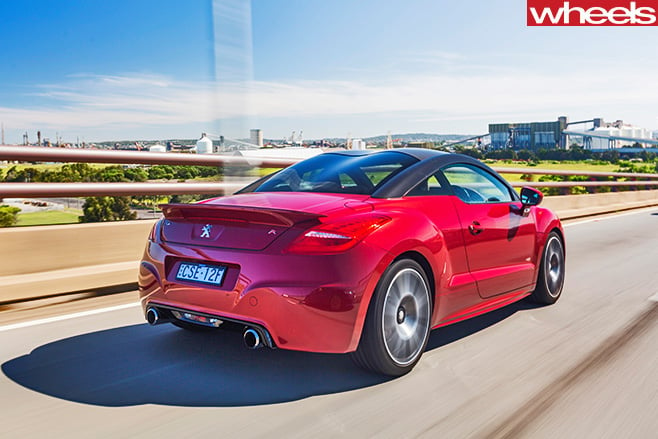
Chunky tyres and broad tracks give the RCZ-R a hunkered-down look, and that’s how it drives, thanks to a reassuring level of steering weight, good balance, well-contained roll and yaw, and damping that can manage all but the biggest hits. However, the Pug’s steering and front end don’t have quite the alacrity of the TT, and with only the front tyres doing the driving via a Torsen LSD, it torque steers.
Inside scoop
THE RCZ-R is not as hushed inside as the TT, and its ride is busier, too, though it does a commendable job of soaking bumps on same-sized 19s, despite our test car not having Audi’s optional adaptive dampers.
Calm in the Alfa’s cabin? Pfft… The best compliment we can pay the 4C is to say it rides well for what it is. The softer base model will likely be more supple – and more subtle – than the sports-suspended Launch Edition version.
But all this is far from the point. In the context of the Alfa Romeo, the Audi and Peugeot are just a couple of sporty coupes. The 4C, meanwhile, is a demanding sports car. It’s undoubtedly the quickest and most capable here, though extracting its best takes more driving skill and commitment than in the others. And therein lies the fun for some, and the deal-breaker for others.
Yes, the Alfa could be better, most obviously with an open-gated manual gearbox, but also with a bit more steering crispness and consistency of weight. A four with individual throttle bodies or a raspy V6 would make for a more visceral, linear experience, and it wouldn’t matter if the 4C wasn’t quite as quick without a turbo.
Still, given the way it looks and goes for the money, the 4C is a brilliant car. It would find closer competition in a Lotus showroom, though the Alfa is more accelerative and/or less expensive, depending on whether you’re comparing it with an Elise or an Exige.
The Salami Army won’t need any convincing – not after all these years – and the 4C’s sharp focus and spectacular aesthetics will surely help it bring new fans to the brand.
Unlike the Audi, though, it hasn’t the breadth of ability to find broad appeal, which makes the artful and accomplished third-generation Bauhaus style icon both the best TT yet and the all-round pick of the coupes.
Inside: Audi TT
TFT-filled instrument cluster and redesigned multimedia interface headline a typically superb effort inside the Audi. The new (still-jet-engine-themed) air-con outlets look cool and bring a neat new mechanism for directing airflow. Like the RCZ-R, a sardine-can back seat trumps not having one at all.
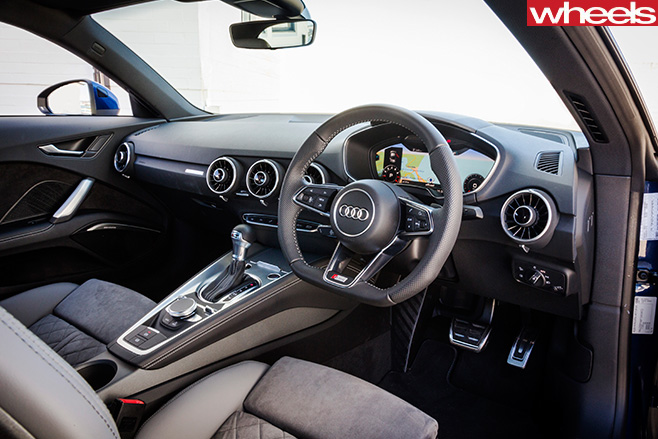
The French car’s cabin looked great in 2009, and holds up quite well today. In ‘R’ form it’s suitably sportified thanks to figure-hugging front seats, and is classed-up with stitched leather splashed across the dash and door trims.
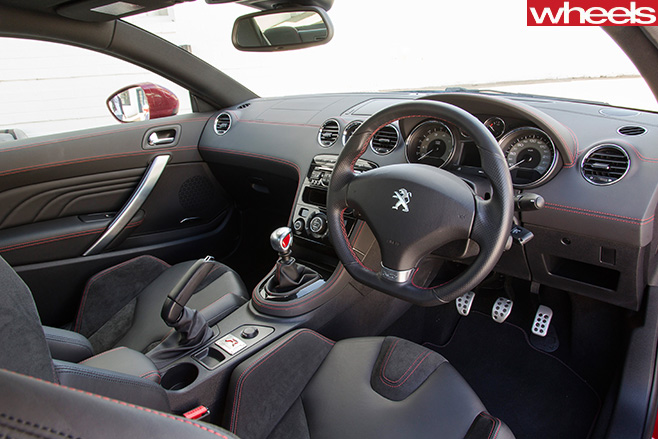
Inside: Alfa Romeo 4C
Exposed carbon floor spells pure race car and is beautifully finished. The seats are uncompromising, but offer unparalleled lateral support, and the small, over-styled wheel is chunky. Most controls are Fiat/Alfa parts-bin, but at this price we’re good with its bespoke ambience and appearance.
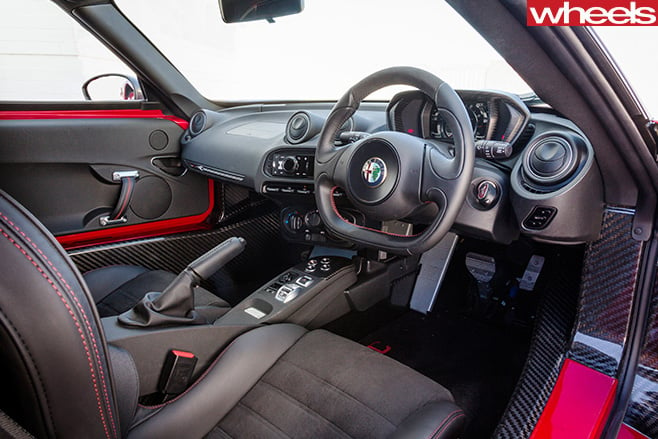
TO THE 4C’s carbonfibre-tub chassis and double A-arm front and strut/multi-link rear suspension, the Launch Edition model adds “racing” dampers and anti-roll bars, and inch-bigger alloys with Pirelli P Zeros. Both versions get Alfa’s Q2 electro-LSD.
The rest of the $20K upgrade is superficial – microfibre seat inserts with contrasting stitching, carbon bits inside, yet more carbon outside, including the exterior mirror shells and rear wing, and the questionably cool headlight surrounds.
The brake upgrade consists merely of a caliper paint job – the discs and four-pot Brembos aren’t any bigger – and engine outputs are unchanged. The ‘sports’ exhaust only enhances acoustics.
DNA strand
DYNAMIC mode in the Alfa’s ‘DNA’ system removes all linearity by applying an aggressive map to throttle and boost control, which exacerbates the induction histrionics.
All-Weather mode delays the onset of mid-range torque, and more surprisingly, makes the exhaust rortier (the turbo wastegate is open more of the time). Race slashes the safety net and introduces a two-level launch control, while Normal provides the best all-round settings.
But the system’s effect is limited (compared with, say, a Giulietta’s), given that it doesn’t take much to get the engine’s small, responsive turbo wound up, or much torque to push 4C’s lean body weight. The Alfa is a rocket regardless.
Verdict
 AUDI TT S-LINE QUATTRO
AUDI TT S-LINE QUATTRO
Price as tested: $93,420 *Includes metallic paint ($1400), Matrix LED headlights ($1900), assistance pack ($2200), quartz finish interior elements ($470), leather pack ($800), Bang & Olufsen sound ($1200)
NCAP rating: 5 stars (Euro)
Fuel economy: 9.3L/100km (test average)
Acceleration: 0-100km/h: 5.5sec (tested)
Plus: Grip and handling; AWD’s rear bias; quick steering; cabin; refinement
Minus: Needs more larrikin in its chassis (TT S could be worth waiting for)
Verdict: 8.0/10
 Alfa ROMEO 4C
Alfa ROMEO 4C
Price as tested: $109,000
NCAP rating: not tested
Fuel economy: 8.5L/100km (test average)
Acceleration: 0-100km/h: 4.6sec (tested)
Plus: Supercar looks; light weight breeds handling and efficiency; involvement
Minus: Unassisted steering not for everyone; too much turbo whoosh
Verdict: 7.5/10
 PEUGEOT RCZ-R
PEUGEOT RCZ-R
Price as tested: $68,990
NCAP rating: not tested
Fuel economy: 8.7L/100km (test average)
Acceleration: 0-100km/h: 6.5sec (tested)
Plus: Engine delivers beyond its capacity; individual styling; sorted chassis
Minus: Cabin can’t match new TT for refinement, class or technology
Verdict: 7.0/10

